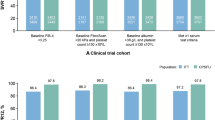Abstract
Background:
Although the mechanism of atazanavir (ATV)-related hyperbilirubinemia is well identified, its prevalence, risk factors, and association with transaminase flares have rarely been assessed in a large population from the “real life” setting.
Methods:
Prospectively collected data on 2,404 patients from the Italian MASTER Cohort and the Italian ATV expanded access program database were examined. Uni- and multivariable Cox proportional hazards regression models were conducted to identify risk factors for grade ≥ III hyperbilirubinemia during the administration of ATV. The risk of increased levels of serum alanine aminotranferase (ALT) was compared between patients with or without grade ≥ III hyperbilirubinemia in a Cox regression analysis stratified by hepatitis C virus (HCV) serostatus.
Results:
Grade III and IV hyperbilirubinemia were observed in 1,072 (44.6%) and 174 (7.2%) of the patients, respectively. Higher CD4+ T-cell counts, abnormal bilirubinemia at baseline, and ritonavir co-administration were associated with a higher risk of developing grade ≥ III hyperbilirubinemia. In contrast, female gender, clinical class C, and non-nucleoside reverse transcriptase co-administration appeared to be protective. Higher bilirubinemia at baseline and the use of ritonavir were associated with a higher risk of grade IV hyperbilirubinemia. The occurrence of grade ≥ III hyperbilirubinemia was not associated with severe hepatotoxicity (hazard ratio 1.00, 95% confidence interval 0.64–1.57; p = 0.997).
Conclusions:
Hyperbilrubinemia is a common side effect of an ATV pharmacotherapeutic regimen. However, grade IV increase in bilirubin was rarely found. In most cases, ATV hyperbilirubinemia appeared to be an innocent phenomenon as far as the risk of a subsequent increase in liver enzyme level is concerned.
Similar content being viewed by others
References
Johnson M, Grinsztejn B, Rodriguez C, et al. Atazanavir plus ritonavir or saquinavir, and lopinavir/ritonavir in patients experiencing multiple virological failures. AIDS 2005; 19: 685–694.
Molina JM, Andrade-Villanueva J, Echevarria J et al.: Efficacy and safety of once-daily atazanavir/ritonavir compared to twicedaily lopinavir/ritonavir, each in combination with tenofovir and emtricitabinein in ARV-naive HIV-1-infected subjects: The CASTLE study, 48-week results (abstract no. 37). Boston, MA: 15th Conference on Retroviruses and Opportunistic Infections, 2008.
Sanne I, Piliero P, Squires K, Thiry A, Schnittman S: Results of a phase 2 clinical trial at 48 weeks (AI424-007): a dose-ranging, safety, and efficacy comparative trial of atazanavir at three doses in combination with didanosine and stavudine in antiretroviral-naive subjects. J Acquir Immune Defic Syndr 2003; 32: 18–29.
Squires K, Lazzarin A, Gatell JM, et al. Comparison of once-daily atazanavir with efavirenz, each in combination with fixed-dose zidovudine and lamivudine, as initial therapy for patients infected with HIV. J Acquir Immune Defic Syndr 2004; 36: 1011–1019.
Ward D, Curtin J, Richardson J et al: Hyperbilirubinemia among Patients in the HIV Outpatient Study (HOPS) receiving atazanavir (abstract TuPe2 1B02). Rio de Janeiro: 3rd International AIDS Conference on HIV Pathogenesis and Treatment, 2005.
Wood R, Phanuphak P, Cahn P, et al. Long-term efficacy and safety of atazanavir with stavudine and lamivudine in patients previously treated with nelfinavir or atazanavir. J Acquir Immune Defic Syndr 2004; 36: 684–692.
Anonymous: 1993 Revised classification system for HIV infection and expanded surveillance case definition for AIDS among adolescents and adults. MMWR Recomm Rep 1992; 41: 1–19.
Al-Mohri H, Cooper C, Murphy T, Klein MB: Validation of a simple model for predicting liver fibrosis in HIV/hepatitis C virus-coinfected patients. HIV Med 2005; 6: 375–378.
Gatell J, Salmon-Ceron D, Lazzarin A, et al. Efficacy and safety of atazanavir-based highly active antiretroviral therapy in patients with virologic suppression switched from a stable, boosted or unboosted protease inhibitor treatment regimen: the SWAN Study (AI424-097) 48-week results. Clin Infect Dis 2007; 44: 1484–1492
Havlir DV, O’Marro SD: Atazanavir: new option for treatment of HIV infection. Clin Infect Dis 2004; 38: 1599–1604.
Murphy RL, Sanne I, Cahn P, et al. Dose-ranging, randomized, clinical trial of atazanavir with lamivudine and stavudine in antiretroviral-naive subjects: 48-week results. AIDS 2003; 17: 2603–2614.
Colombo S, Buclin T, Cavassini M, et al. Population pharmacokinetics of atazanavir in patients with human immunodeficiency virus infection. Antimicrob Agents Chemother 2006; 50: 3801–3808.
Dailly E, Tribut O, Tattevin P, et al. Influence of tenofovir, nevirapine and efavirenz on ritonavir-boosted atazanavir pharmacokinetics in HIV-infected patients. Eur J Clin Pharmacol 2006; 62: 523–526.
Smith DE, Jeganathan S, Ray J: Atazanavir plasma concentrations vary significantly between patients and correlate with increased serum bilirubin concentrations. HIV Clin Trials 2006; 7: 34–38.
Rotger M, Taffe P, Bleiber G, et al. Gilbert syndrome and the development of antiretroviral therapy-associated hyperbilirubinemia. J Infect Dis 2005; 192: 1381–1386.
Johnson M, Grinsztejn B, Rodriguez C, et al. 96-week comparison of once-daily atazanavir/ritonavir and twice-daily lopinavir/ritonavir in patients with multiple virologic failures. AIDS 2006; 20: 711–718.
Author information
Authors and Affiliations
Corresponding author
Additional information
C. Torti and G. Lapadula equally contributed to this study.
This work was partially presented during the 11th European AIDS Conference, 24–27 Oct 2007, at Madrid, Spain (abstract P9.6/03).
Rights and permissions
About this article
Cite this article
Torti, C., Lapadula, G., Antinori, A. et al. Hyperbilirubinemia during Atazanavir Treatment in 2,404 Patients in the Italian Atazanavir Expanded Access Program and MASTER Cohorts. Infection 37, 244–249 (2009). https://doi.org/10.1007/s15010-008-8010-6
Received:
Accepted:
Published:
Issue Date:
DOI: https://doi.org/10.1007/s15010-008-8010-6




